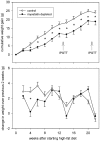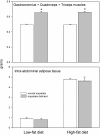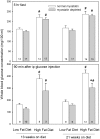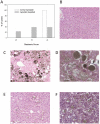Effect of myostatin depletion on weight gain, hyperglycemia, and hepatic steatosis during five months of high-fat feeding in mice
- PMID: 21390326
- PMCID: PMC3044753
- DOI: 10.1371/journal.pone.0017090
Effect of myostatin depletion on weight gain, hyperglycemia, and hepatic steatosis during five months of high-fat feeding in mice
Abstract
The marked hypermuscularity in mice with constitutive myostatin deficiency reduces fat accumulation and hyperglycemia induced by high-fat feeding, but it is unclear whether the smaller increase in muscle mass caused by postdevelopmental loss of myostatin activity has beneficial metabolic effects during high-fat feeding. We therefore examined how postdevelopmental myostatin knockout influenced effects of high-fat feeding. Male mice with ubiquitous expression of tamoxifen-inducible Cre recombinase were fed tamoxifen for 2 weeks at 4 months of age. This depleted myostatin in mice with floxed myostatin genes, but not in control mice with normal myostatin genes. Some mice were fed a high-fat diet (60% of energy) for 22 weeks, starting 2 weeks after cessation of tamoxifen feeding. Myostatin depletion increased skeletal muscle mass ∼30%. Hypermuscular mice had ∼50% less weight gain than control mice over the first 8 weeks of high-fat feeding. During the subsequent 3 months of high-fat feeding, additional weight gain was similar in control and myostatin-deficient mice. After 5 months of high-fat feeding, the mass of epididymal and retroperitoneal fat pads was similar in control and myostatin-deficient mice even though myostatin depletion reduced the weight gain attributable to the high-fat diet (mean weight with high-fat diet minus mean weight with low-fat diet: 19.9 g in control mice, 14.1 g in myostatin-deficient mice). Myostatin depletion did not alter fasting blood glucose levels after 3 or 5 months of high-fat feeding, but reduced glucose levels measured 90 min after intraperitoneal glucose injection. Myostatin depletion also attenuated hepatic steatosis and accumulation of fat in muscle tissue. We conclude that blocking myostatin signaling after maturity can attenuate some of the adverse effects of a high-fat diet.
Conflict of interest statement
Figures





References
-
- Zhao B, Wall RJ, Yang J. Transgenic expression of myostatin propeptide prevents diet-induced obesity and insulin resistance. Biochem Biophys Res Commun. 2005;337:248–255. - PubMed
-
- Hamrick MW, Pennington C, Webb CN, Isales CM. Resistance to body fat gain in 'double-muscled' mice fed a high-fat diet. Int J Obes. 2006;30:868–870. - PubMed
-
- Yang J, Zhao B. Postnatal expression of myostatin propeptide cDNA maintained high muscle growth and normal adipose tissue mass in transgenic mice fed a high-fat diet. Mol Reprod Dev. 2006;73:462–469. - PubMed
Publication types
MeSH terms
Substances
Grants and funding
LinkOut - more resources
Full Text Sources
Medical
Molecular Biology Databases

